U.S. President Donald J. Trump signed the nearly 900-page One Big Beautiful Bill Act into law on July 4. The budget reconciliation legislation extends numerous provisions included in the 2017 Tax Cuts and Jobs Act that directly affect commercial real estate, including reinstatement of bonus depreciation and extension of the Qualified Opportunity Zone Program. It also incorporates provisions aimed at incentivizing affordable housing, including a significant expansion of the Low-Income Housing Tax Credit (LIHTC) program. At the same time, the new law makes major cuts to wind and solar incentives.
Urban Land: What provisions do you think will have the biggest impact on commercial real estate, housing, or both, and why?
Randall Sakamoto, president, Rosen Consulting Group and managing director, Andersen
There were positives, perhaps particularly with what was not included, as well as some potential negatives. So, a bit of a mixed bag for the industry.
Making bonus depreciation permanent should help free up capital, but it is unlikely to drive a large surge in new investment right away. It may make some marginal deals pencil financially. A specific carve-out for bonus depreciation for manufacturing facilities could help spur domestic production as tariffs shift supply chains. If you haven’t already, call your cost segregation service provider, because they are going to be booked solid soon.
The affordable housing provisions may have the biggest real estate impact. The permanent reduction of the LIHTC bond test and increase in the 9 percent allocation program, combined with the permanent new market tax credits, could lead to tens of thousands of new affordable housing units. In a vacuum, this [combination] would clearly have the biggest impact. But I can’t ignore the impact of the loss of block grants and government workers who administer and review developments within the various affordable housing programs.
In some ways, programs that did not change or survived the chopping block are the most impactful for the industry. In early discussions on the bill, there was the potential to lose 1031 exchanges, eliminate the pass-through entity tax workaround for personal SALT deductions, limit or eliminate the corporate state and local tax—SALT—deduction, increase taxes on carried interest, and introduce a retaliatory tax on inbound investment. Each of these would have had a substantial negative impact. None came through in the final bill, and that should benefit the real estate industry in the coming years.
Overall, the bill is a slight positive, but it really was a lost opportunity for a bigger win for the real estate industry.
Thomas LaSalvia PhD, head of commercial real estate economics, Moody’s Analytics
Legislation of this scope and magnitude is often enacted to shift incentive structures and promote growth in specific sectors. However, unintended consequences frequently arise as markets adapt to these reforms. We anticipate that the modifications to clean energy tax credits for wind and solar could have the most significant impact on commercial real estate and housing. The Inflation Reduction Act and other initiatives by the previous administration spurred substantial construction spending on new manufacturing facilities and created demand for new logistics, suppliers, and housing networks through clean energy credits.
Reforms to the Qualified Opportunity Zone program—and notably the new permanency of the program—will continue to encourage growth in [commercial real estate] and housing within designated areas, though the outcomes will be intentionally limited in scope. Expanding the LIHTC [low-income housing tax credit] program will also stimulate growth in affordable housing, especially as the pipeline for multifamily housing slows in response to the recent surge in completions.
However, neither of these efforts is expected to result in [shifts as significant as] the changes to energy policies. The bill’s revised energy policies—which involve eliminating certain tax credits while maintaining others, along with implementing restrictions on foreign entities of concern—will transform construction project plans, pipelines, and finances. While we might see a short-term surge in construction activity as stakeholders rush to meet deadlines set by the bill, the longer-term ramifications of these policy changes remain uncertain, due to the extent of the revisions and necessary adjustments to the development process.
Chad Littell, national director of Capital Markets Analytics at CoStar Group
The passage of the One Big Beautiful Bill Act boosts commercial real estate by combining long-term tax incentives with targeted tools aimed at development, investment, and renewal across various property types. The legislation introduces changes in three key areas: investment expensing rules, small business deduction thresholds, and revitalization incentives.
Full expensing through bonus depreciation of equipment investment is made permanent, allowing landlords across all property types to immediately deduct improvements such as interior buildouts, lighting, and HVAC, improving profitability and likely spurring more investment. Manufacturers also benefit as qualifying production areas within newly constructed facilities are eligible for the same treatment, even though entire buildings typically are not. Furthermore, Section 179 deduction limits were also raised to $2.5 million, offering more flexibility for small and mid-sized businesses to manage taxable income through selective expensing.
Affordable housing financing should become more accessible and could spur more development amid our current housing shortage. The Low-Income Housing Tax Credit (LIHTC) and New Markets Tax Credit (NMTC) were made permanent, and the bond financing threshold for 4 percent LIHTC deals was lowered to 25 percent, a shift that supports the development of new mixed-income housing.
Also encouraging is what is not in the bill. Section 1031 exchanges remain fully intact. There’s no new cap on deferred gains, no additional reporting, and no structural changes—welcome news for high-value transactions and longtime real estate investors.
These provisions offer a constructive tailwind and greater clarity around incentives and timelines. While they won’t entirely reshape the industry, they offer new precision tools that support investment in targeted real estate segments and geographies.
Victor Calanog, global co-head of research and strategy, real estate, Manulife IM
There are several provisions in H.R. 1 [House designation for the Big Beautiful Bill] that will directly impact the housing market and real estate development. Specifically, it allows manufacturers to write off qualifying real estate investments via new depreciation returns, providing incentives for developers. Opportunity Zone benefits were made permanent. LIHTC provisions were expanded as well. One hundred percent bonus depreciation provisions will boost construction of new facilities.
The big macro-question is whether higher deficits will act as upward pressure on long-term rates. Even if the Fed lowers short-term interest rates, lenders may demand higher rates to lend at longer durations to the [United States]. Supercharged economic growth and productivity will help offset some of this, but it remains to be seen whether that will be achievable [through] this bill.
Daniel Aldrich, director, MS Resilience Studies Program, and Dean’s Professor of Resilience, Northeastern University
The reinstatement of 100 percent bonus depreciation for property acquired after January 19, 2025, will significantly boost development by allowing immediate equipment write-offs. Manufacturers can now immediately write off qualifying real estate investments, spurring industrial development. LIHTC expansion increases 9 percent credit allocations by 12.5 percent, through 2029 and lowers bond-financing thresholds to 25 percent for 4 percent LIHTC projects—perhaps the biggest investment in the housing credit in 25 years. This is crucial as climate disasters increasingly displace vulnerable populations. The Qualified Opportunity Zone program becomes permanent with reduced improvement requirements—50 percent instead of 100 percent—for rural areas, though critics note it has disproportionately produced market-rate housing in non-low-income areas.
Most concerning is the phase-out of wind, solar, and EV tax credits. Residential solar credits end December 31, 2025 . . . . Utility-scale projects must enter service by 2027 for credits. U.S. emissions will now drop just 3 percent by decade’s end, versus the previous 40 percent target. Additionally, nearly 12 million people could lose Medicaid coverage, reducing health care access and [adding to] household precarity as climate risks increase. The elimination of energy efficiency incentives will particularly harm low-income households facing rising utility costs from extreme weather, while reduced renewable energy deployment will increase long-term energy costs, housing vulnerability, and climate risks for disadvantaged communities.
John Chang, chief intelligence & analytics officer, Marcus & Millichap
While the recently finalized One Big Beautiful Bill Act largely focuses on renewing existing tax structures and policies, it does offer the commercial real estate sector a variety of unique opportunities and incentives.
- The expansion of the LIHTC program will help address the significant shortage of affordable housing while bolstering development and investment in these assets
- · The renewal of Qualified Opportunity Zones has the potential to generate redevelopment and renewal of underserved and distressed communities, while also enticing fresh capital to the sector through capital gains tax deferment and a 10 percent step-up basis
- The reinvigoration of 100 percent bonus depreciation has the potential to bolster commercial real estate investment activity by increasing first-year returns, especially for assets with going-in cap rates at or near the currently elevated rates on debt capital
All of these provisions have the potential to reactivate capital that may have been sidelined by the higher interest rate climate. An aspect of the One Big Beautiful Bill that offers the most promise is the fact that it made these policies permanent, without requiring renewal every few years. That change will enable commercial real estate investors to develop longer-term strategies that more effectively capitalize on the policies and programs created.
The changes codified in the new legislation will drive several long-run trends. These include increased construction of affordable housing through the expanded LIHTC program, development and renewal in distressed areas through Opportunity Zones, and active investment and value-add redevelopment leveraging 100 percent bonus depreciation. The permanence of these policies could create a paradigm shift in the commercial real estate sector as investors will no longer need to squeeze strategies focused on long-term commercial real estate investments into a narrow window of time. The new tax rules will empower investors to leverage long-term tax planning and long-term strategies that focus on an extended investment horizon.
Christopher Thornberg PhD, founding partner, Beacon Economics
The One Big Beautiful Bill Act of 2025 has plenty of good news for the commercial real estate world—perhaps not surprising, given the President’s interest in the industry. The real danger in this bill is that it is trying to heat up an already overheated economy.
The Trump administration inherited an economy . . . marked by massive public deficits, sky-high asset prices, and an expanding current account deficit. The U.S. economy has managed to get into this overheated space with rising interest rates because of massive flows of global portfolio investments moving into the nation, likely chasing yields in our overheated asset markets. Depending on who you listen to, the Big Bill will expand the national debt by between $3 [trillion] and $4 trillion over the next decade, on top of an already record-high deficit and debt level, which will put even more stress on this already fragile equilibrium.
If foreign investors flinch and start to withdraw their capital, it will be marked by a sharp decline in the U.S. dollar and another surge in interest rates—ultimately, a far larger issue for commercial real estate than the pace of depreciation of housing tax credits.
Past Snapshots:












